Flexible IoT Gas Sensor Node for Automated Life Science Environments Using Stationary and Mobile Robots
Abstract
:1. Introduction
2. System Concept and Implementation
2.1. Gas Sensor Node
2.1.1. Microcontroller Board
2.1.2. Sensor Board
2.1.3. Communication Board
2.1.4. Power/Battery Board
2.1.5. Inter-Board Connection
2.2. Communication
3. Experimental Methods and Results
3.1. Investigations under Laboratory Conditions
3.1.1. Sensor Orientation
3.1.2. Reactivity of Sensors
3.1.3. Sensors’ Reaction Related to Different VOCs
- C2H5OH—ethanol (70%, technical grade)
- CH2O2—formic acid (≥98%)
- CH2Cl2—dichloromethane
- C2H3N—acetonitrile
- C6H14—hexane
3.2. Application-Related Investigations
3.2.1. Stationary Transport Robot: TS60 (Stäubli)
- 2% speed: 1:16:52
- 5% speed: 00:31:15
- 10% speed: 00:15:93
- 25% speed: 00:06:84
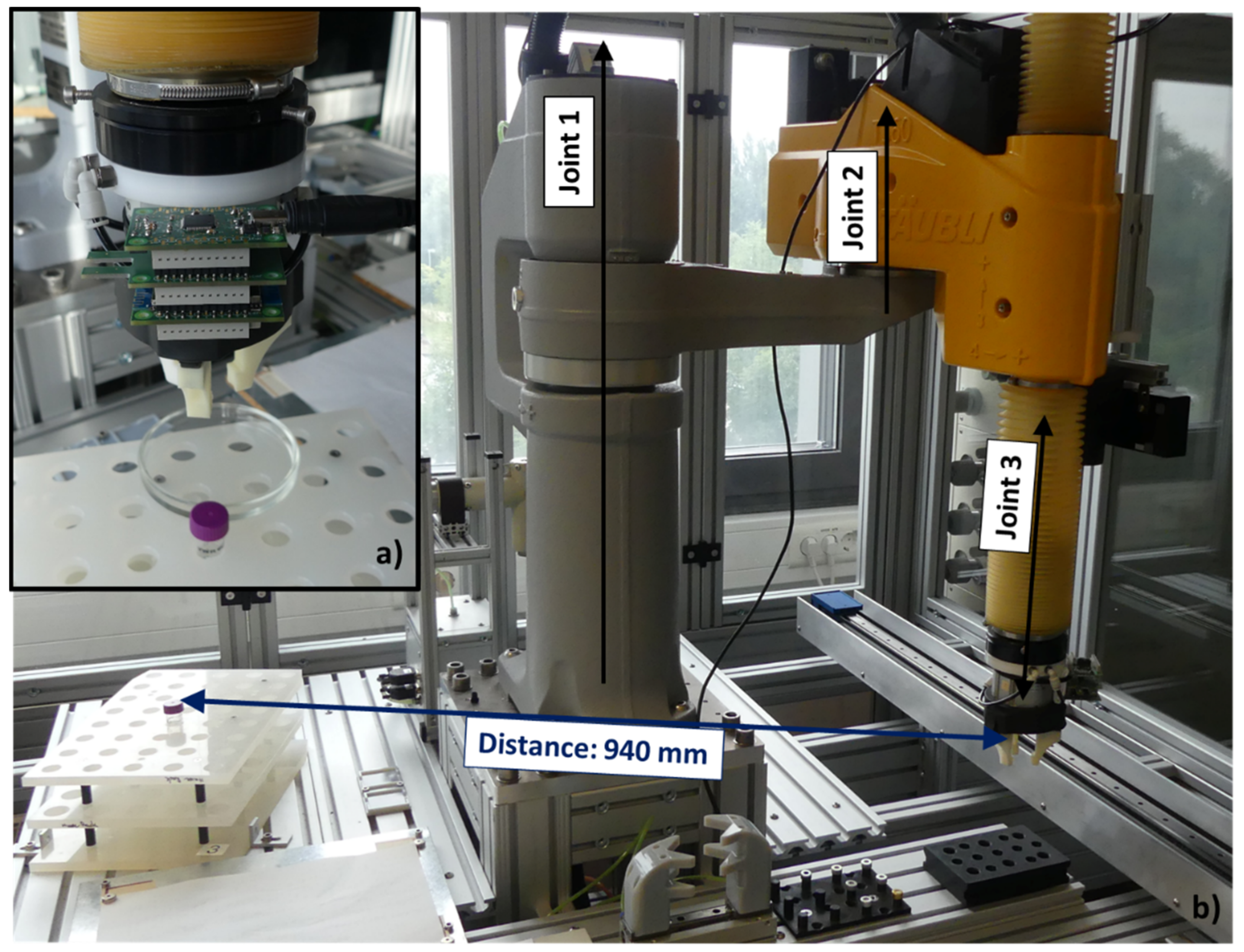
3.2.2. Mobile Robot: H20 (Dr. Robot)
4. Discussion and Conclusions
Author Contributions
Funding
Institutional Review Board Statement
Informed Consent Statement
Data Availability Statement
Acknowledgments
Conflicts of Interest
References
- Wojtczyk, M.; Panin, G.; Lenz, C.; Röder, T.; Nair, S.; Roth, E.; Knoll, A.; Heidemann, R.; Joeris, K.; Zhang, C.; et al. A vision based human robot interface for robotic walkthroughs in a biotech laboratory. In Proceedings of the 4th ACM/IEEE International Conference on Human-Robot Interaction (HRI), La Jolla, CA, USA, 9–13 March 2009; pp. 309–310. [Google Scholar]
- Burger, B.; Maffettone, P.M.; Gusev, V.V.; Aitchison, C.M.; Bai, Y.; Wang, X.; Li, X.; Alston, B.M.; Li, B.; Clowes, R.; et al. A mobile robotic chemist. Nature 2020, 583, 237–241. [Google Scholar] [CrossRef] [PubMed]
- Liu, H.; Stoll, N.; Junginger, S.; Thurow, K. Mobile robot for life science automation. Int. J. Adv. Robot. Syst. 2013, 10, 288. [Google Scholar] [CrossRef] [Green Version]
- Wang, H.; Nie, L.; Li, J.; Wang, Y.; Wang, G.; Wang, J.; Hao, Z. Characterization and assessment of volatile organic compounds (VOCs) emissions from typical industries. Chin. Sci. Bull. 2013, 58, 724–730. [Google Scholar] [CrossRef] [Green Version]
- Guo, X.; Shen, Y.; Liu, W.; Chen, D.; Liu, J. Estimation and prediction of industrial VOC emissions in Hebei Province, China. Atmosphere 2021, 12, 530. [Google Scholar] [CrossRef]
- Szulczyński, B.; Gębicki, J. Currently commercially available chemical sensors employed for detection of volatile organic compounds in outdoor and indoor air. Environments 2017, 4, 21. [Google Scholar] [CrossRef] [Green Version]
- United States Environmental Protection Agency. Volatile Organic Compounds’ Impact on Indoor Air Quality. Available online: https://www.epa.gov/indoor-air-quality-iaq/volatile-organic-compounds-impact-indoor-air-quality (accessed on 31 August 2021).
- Win-Shwe, T.T.; Fujimaki, H.; Arashidani, K.; Kunugita, N. Indoor volatile organic compounds and chemical sensitivity reactions. Clin. Dev. Immunol. 2013, 2013, 623812. [Google Scholar] [CrossRef] [PubMed] [Green Version]
- Yaqoob, U.; Younis, M.I. Chemical gas sensors: Recent developments, challenges, and the potential of machine learning—A review. Sensors 2021, 21, 2877. [Google Scholar] [CrossRef] [PubMed]
- Mirzaeia, A.; Leonardib, S.G.; Nerib, G. Detection of hazardous volatile organic compounds (VOCs) by metal oxide nanostructures-based gas sensors: A review. Ceram. Int. 2016, 42, 15119–15141. [Google Scholar] [CrossRef]
- Malky, S.; Kostanic, I.; Altheiab, K.; Alharbai, W. Evaluation of precalibrated electrochemical gas sensors for air quality monitoring systems. In Proceedings of the International Conference on Internet of Things (iThings) and IEEE Green Computing and Communications (GreenCom) and IEEE Cyber, Physical and Social Computing (CPSCom) and IEEE Smart Data (SmartData), Atlanta, GA, USA, 14–17 July 2019; pp. 967–973. [Google Scholar]
- Xiaoyuan, Y.; Jiwei, D.; Tianjie, Y.; Qingfu, Q. A method for improving detection of gas concentrations using quadrotor. In Proceedings of the IEEE Information Technology Networking, Electronic and Automation Control Conference, Chongqing, China, 20–22 May 2016; pp. 971–975. [Google Scholar]
- Velladurai, V.S.; Saravanan, M.; Vigneshbabu, R.; Karthikeyan, P.; Dhlipkumar, A. Human safety system in drainage, unused well and garbage alerting system for smart city. In Proceedings of the International Conference on I-SMAC (IoT in Social, Mobile, Analytics and Cloud) (I-SMAC), Palladam, Tamil Nadu, India, 10–11 February 2017; pp. 6–9. [Google Scholar]
- Ishigaki, Y.; Enoki, K.; Yokogawa, S. Accuracy verification of low-cost CO2 concentration measuring devices for general use as a countermeasure against COVID-19. medRxiv 2021. [Google Scholar] [CrossRef]
- Sussmann, R.; Rettinger, M. Can we measure a COVID-19-related slowdown in atmospheric CO2 growth? Sensitivity of total carbon column observations. Remote Sens. 2020, 12, 2387. [Google Scholar] [CrossRef]
- Joshna, V.; Kashyap, M.; Ananya, V.; Manitha, P.V. Fully autonomous robot to detect and degasify hazardous gas after flood disaster. In Proceedings of the 2nd International Conference on Power and Embedded Drive Control (ICPEDC), Chennai, India, 21–23 August 2019; pp. 134–139. [Google Scholar]
- Zhigang, N.; Lu, W. Hazardous gas detecting method applied in coal mine detection robot. In Proceedings of the 3rd International Conference on Measuring Technology and Mechatronics Automation, Shangshai, China, 6–7 January 2011; pp. 308–311. [Google Scholar]
- Vallathan, G.; Shiny, X.S.A.; Loga, K. Detection of hazardous gas using wearable wireless sensor networks for industrial applications. In Proceedings of the International Conference on System Computation, Automation and Networking (ICSCAN) 2020, Pondicherry, India, 3–4 July 2020; pp. 1–6. [Google Scholar]
- Benammar, M.; Abdaoui, A.; Ahmad, S.; Touati, F.; Kadri, A. A modular IoT platform for real-time indoor air quality monitoring. Sensors 2018, 18, 581. [Google Scholar] [CrossRef] [PubMed] [Green Version]
- Addabbo, T.; Fort, A.; Mugnaini, M.; Parrino, L.S.; Pozzebon, A.; Vignoli, V. A low power IoT architecture for the monitoring of chemical emissions. Acta IMEKO 2019, 8, 53–61. [Google Scholar] [CrossRef]
- United States Environmental Protection Agency. Particulate Matter (PM) Basics. Available online: https://www.epa.gov/pm-pollution/particulate-matter-pm-basics#PM (accessed on 26 August 2021).
- Zhao, L.; Wu, W.; Li, S. Design and implementation of an IoT-based indoor air quality detector with multiple communication interfaces. IEEE Internet Things J. 2019, 6, 9621–9632. [Google Scholar] [CrossRef]
- Marques, G.; Pitarma, R. An Internet of Things-based environmental quality management system to supervise the indoor laboratory conditions. Appl. Sci. 2019, 9, 438. [Google Scholar] [CrossRef] [Green Version]
- Wall, D.; McCullagh, P.; Cleland, I.; Bond, R. Development of an Internet of Things solution to monitor and analyse indoor air quality. Internet Things 2021, 14, 100392. [Google Scholar] [CrossRef]
- Arroyo, P.; Meléndez, F.; Suárez, J.I.; Herrero, J.L.; Rodríguez, S.; Lozano, J. Electronic nose with digital gas sensors connected via Bluetooth to a smartphone for air quality measurements. Sensors 2020, 20, 786. [Google Scholar] [CrossRef] [PubMed] [Green Version]
- Jose, J.; Sasipraba, T. Indoor air quality monitors using IoT sensors and LPWAN. In Proceedings of the 3rd International Conference on Trends in Electronics and Informatics (ICOEI), Tirunelveli, India, 23–25 April 2019; pp. 633–637. [Google Scholar]
- Umweltbundesamt. Beurteilung von Innenraumluftkontaminationen mittels Referenz- und Richtwerten. Bundesgesundheitsbl–Gesundh–Gesundh. 2007, 7, 990–1005. [Google Scholar]
- Bosch Sensortec. BME688. Digital Low Power Gas, Pressure, Temperature & Humidity Sensor with AI; Bosch Sensortec: Reutlingen, Germany, 2021. [Google Scholar]
- Sensirion. Indoor Air Quality Sensor for TVOC and CO2eq Measurements; Sensirion: Stäfa, Switzerland, 2020. [Google Scholar]
- TE Connectivity. MS5803-05BA—Miniature Altimeter and Diving Module; TE Connectivity: Berwin, PA, USA, 2015. [Google Scholar]
- Yurko, G.; Roostaei, J.; Dittrich, T.; Xu, L.; Ewing, M.; Zhang, Y.; Shreve, G. Real-time sensor response characteristics of 3 commercial metal oxide sensors for detection of BTEX and chlorinated aliphatic hydrocarbon organic vapors. Chemosensors 2019, 7, 40. [Google Scholar] [CrossRef] [Green Version]
- Bosch Sensortec. Gas Sensor BME688. Available online: https://www.bosch-sensortec.com/products/environmental-sensors/gas-sensors/bme688/ (accessed on 26 August 2021).
- Markowicz, P.; Larsson, L. Influence of relative humidity on VOC concentrations in indoor air. Environ. Sci. Pollut. Res. Int. 2015, 22, 5772–5779. [Google Scholar] [CrossRef]
- Abade, B.M.G. Context-Aware Improved Experiences in Smart Environments. Master’s Thesis, University of Coimbra, Coimbra, Portugal, April 2018. [Google Scholar]
- Zhesi, C.; Zhuo, C.; Zhilong, S.; Wenhao, Y.; Zhiyong, F. Smart gas sensor arrays powered by artificial intelligence. J. Semicond. 2019, 40, 111601. [Google Scholar]
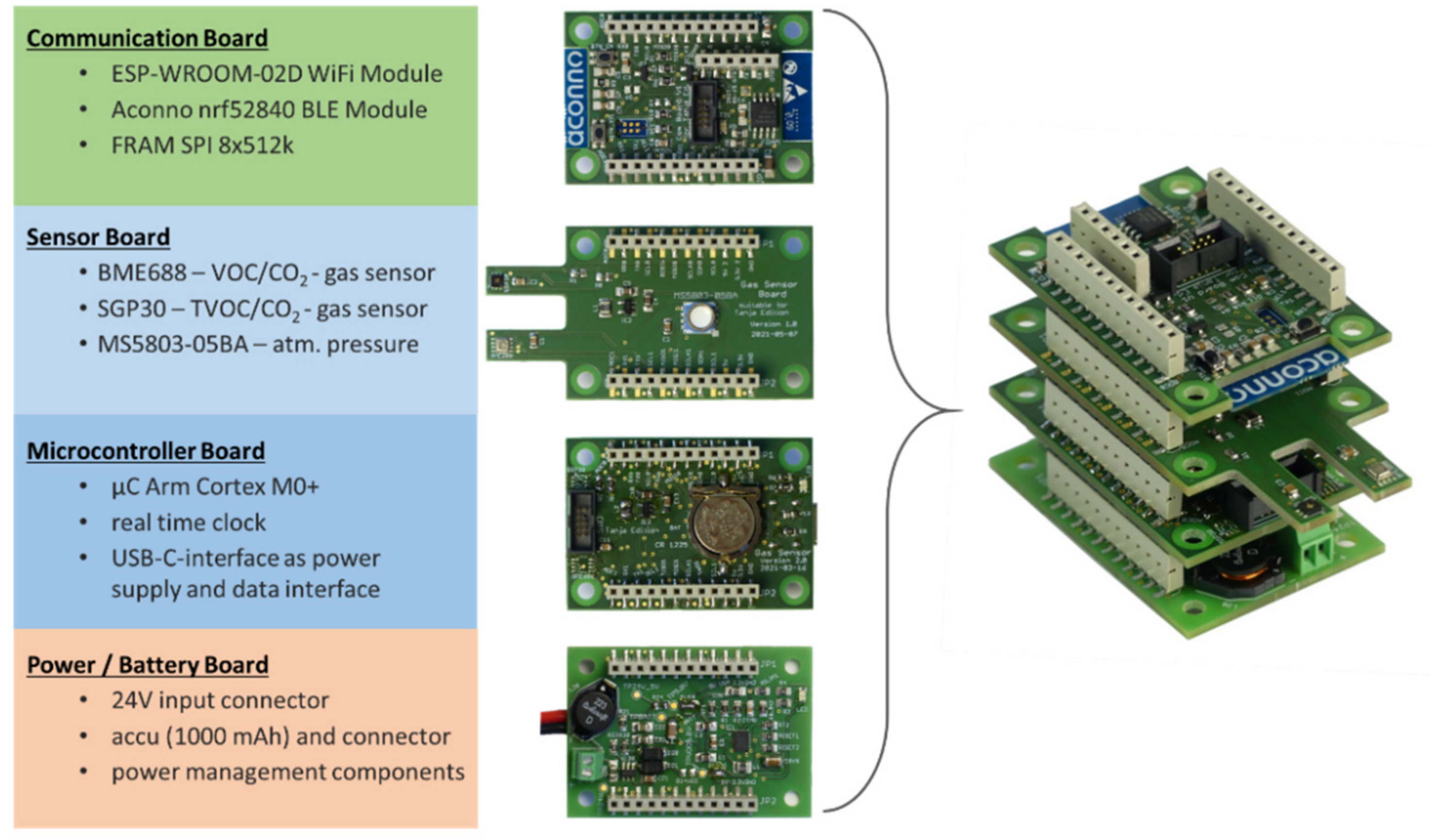

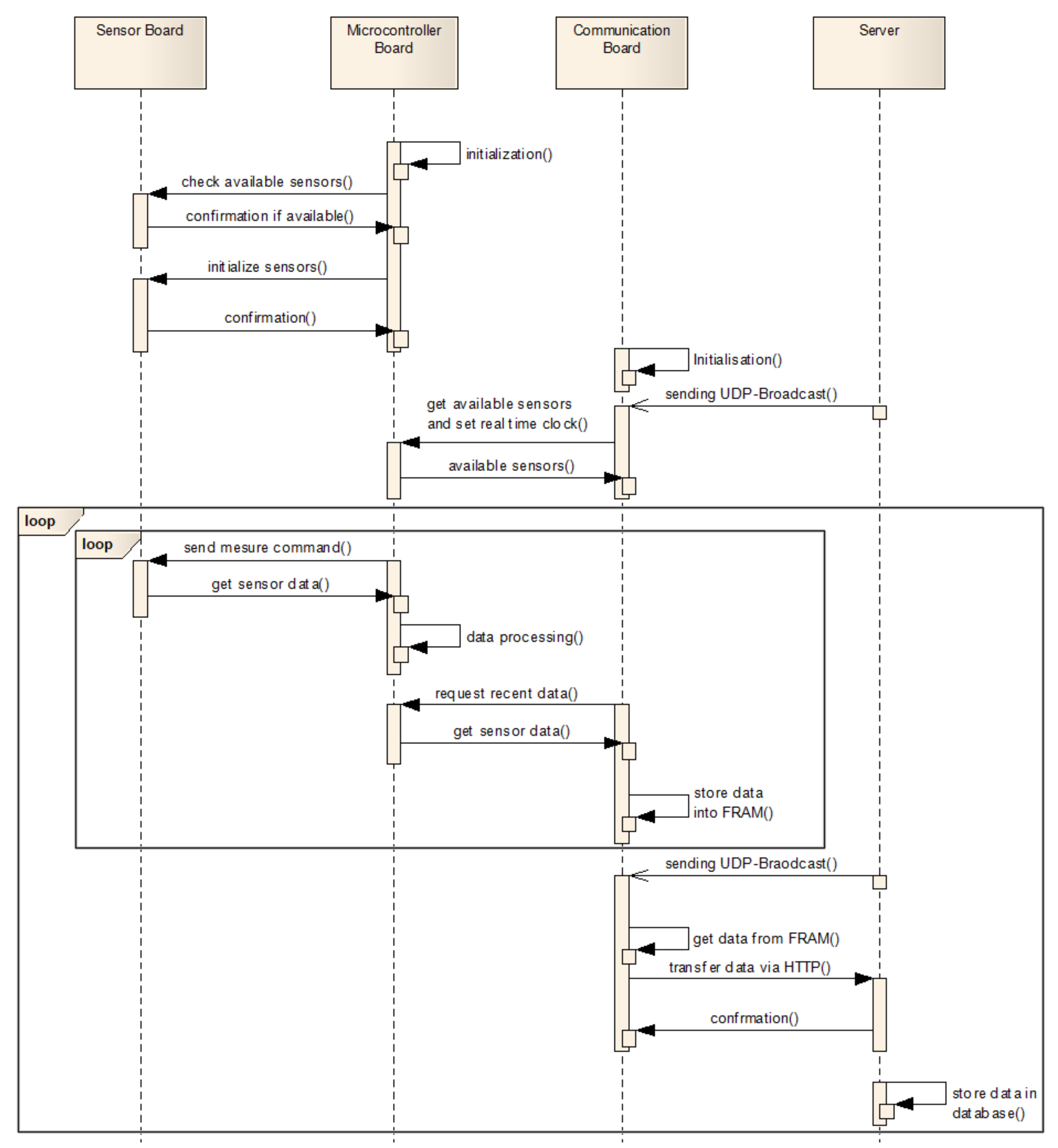
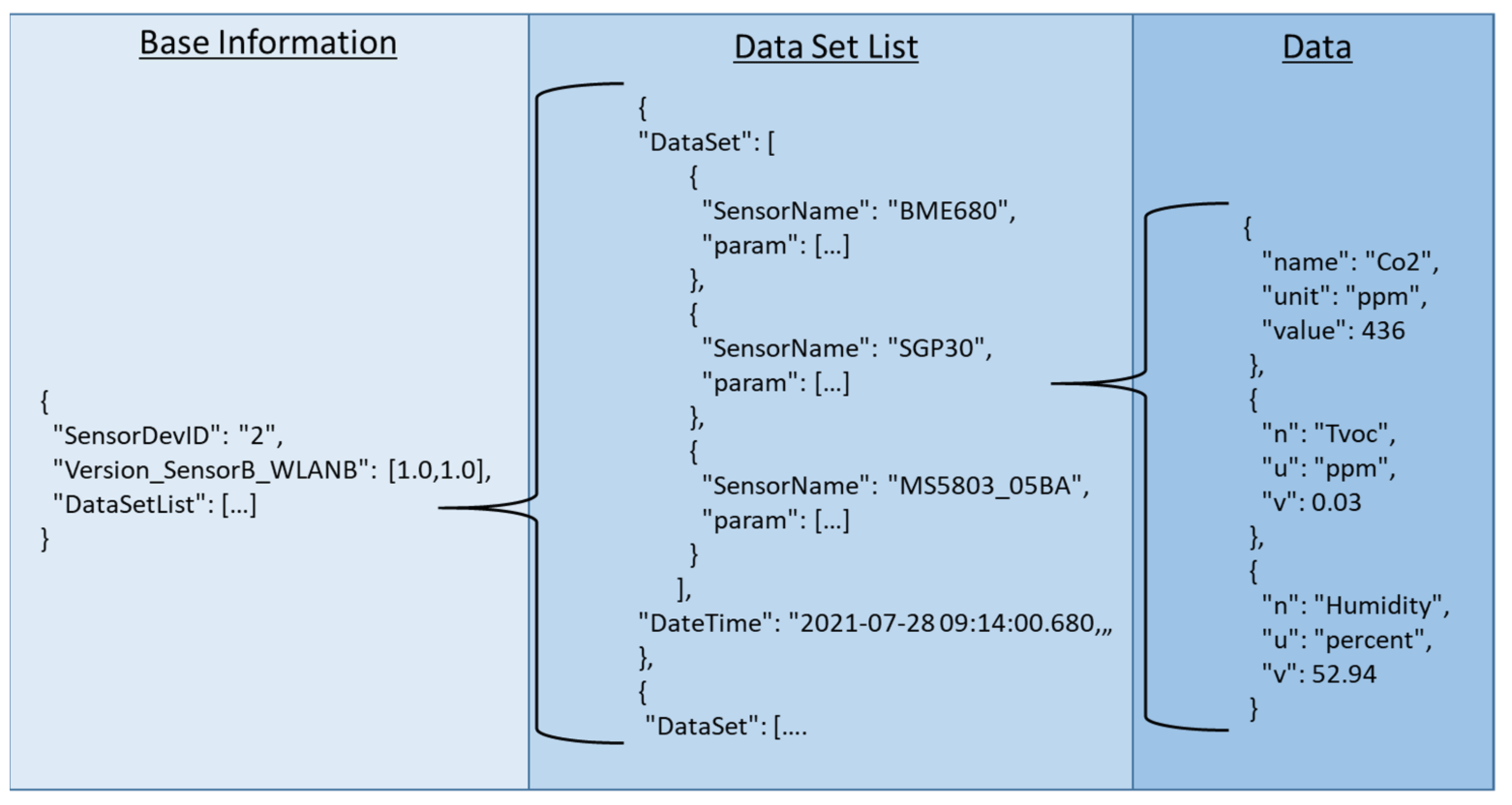

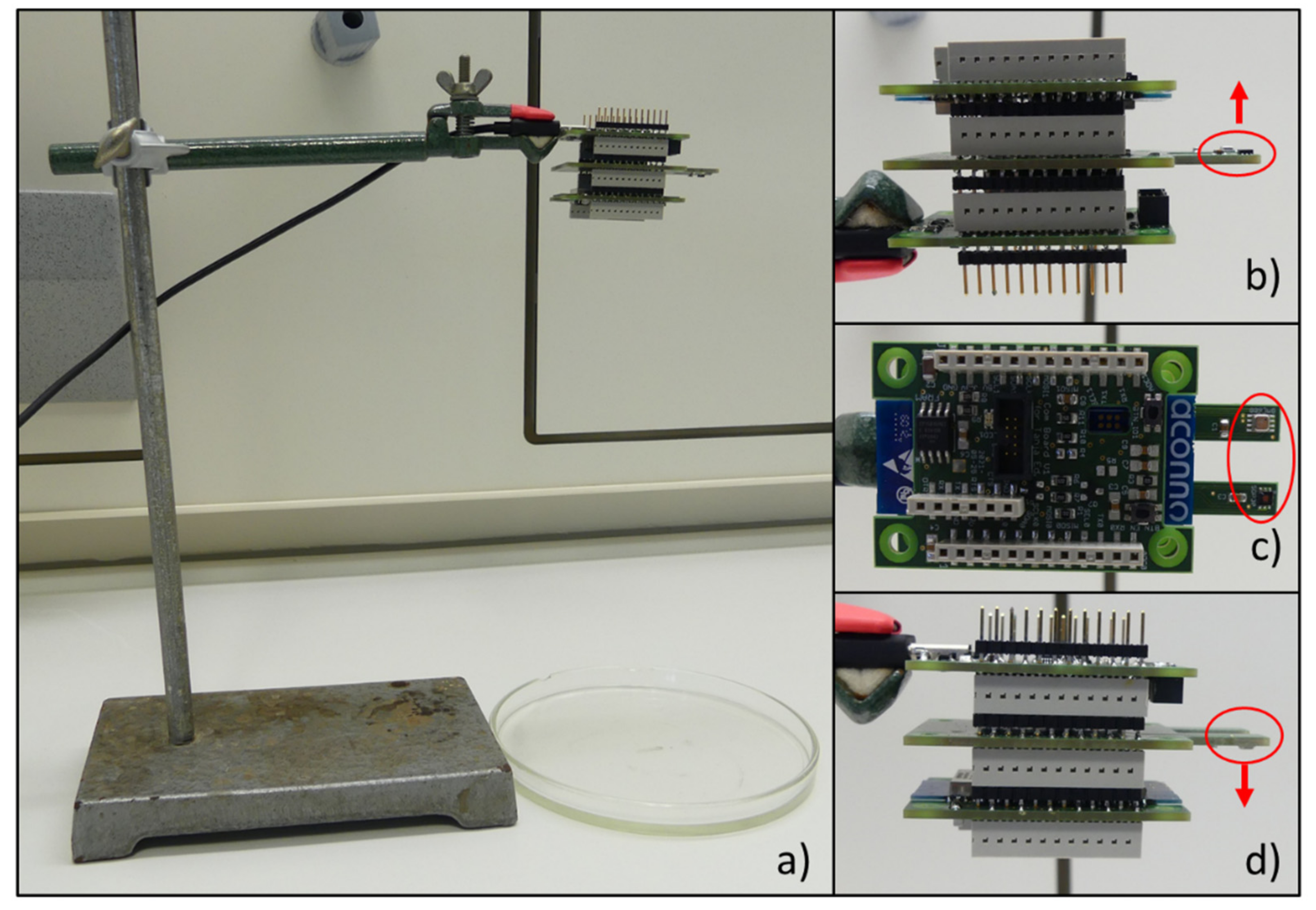
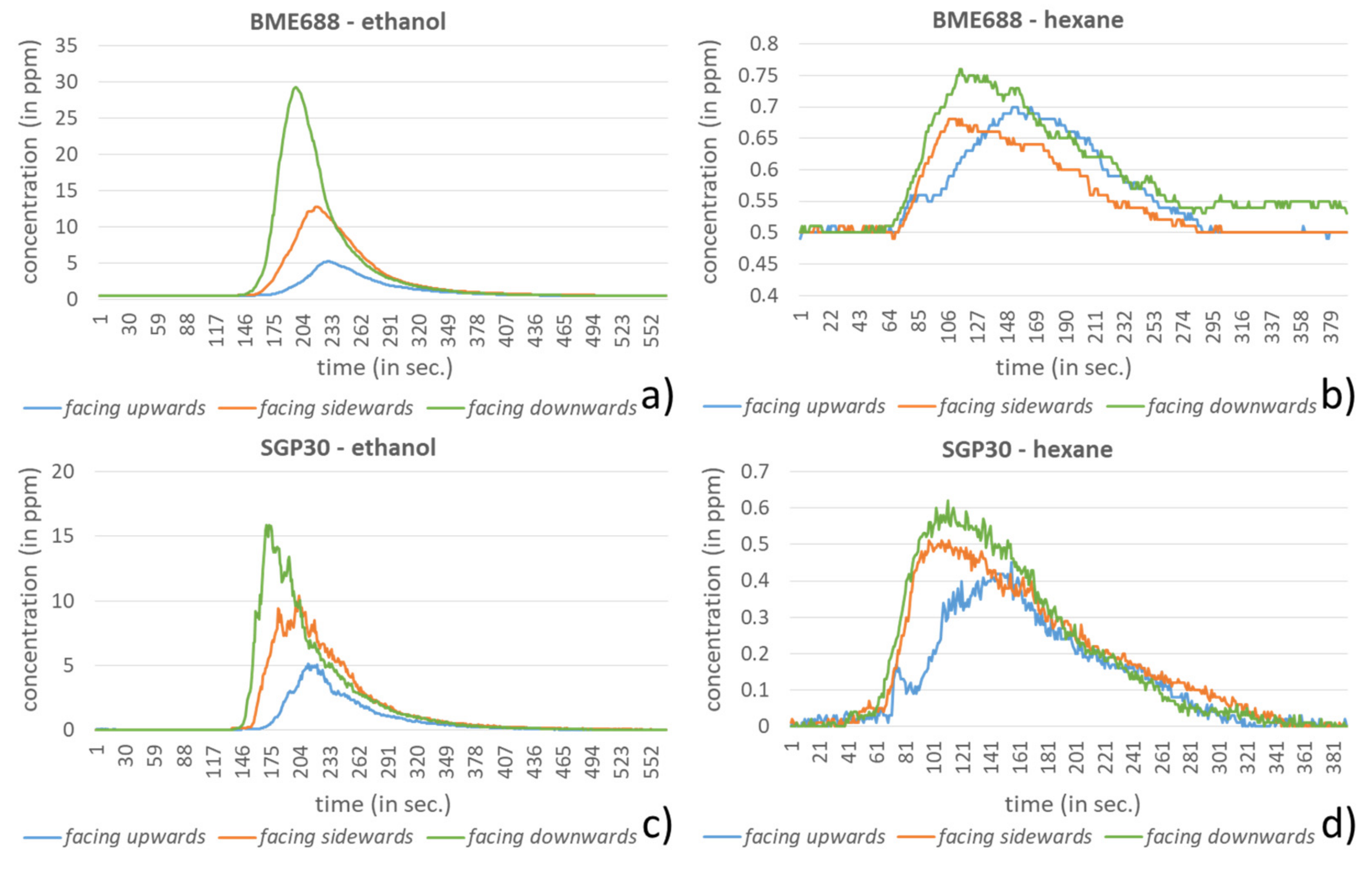


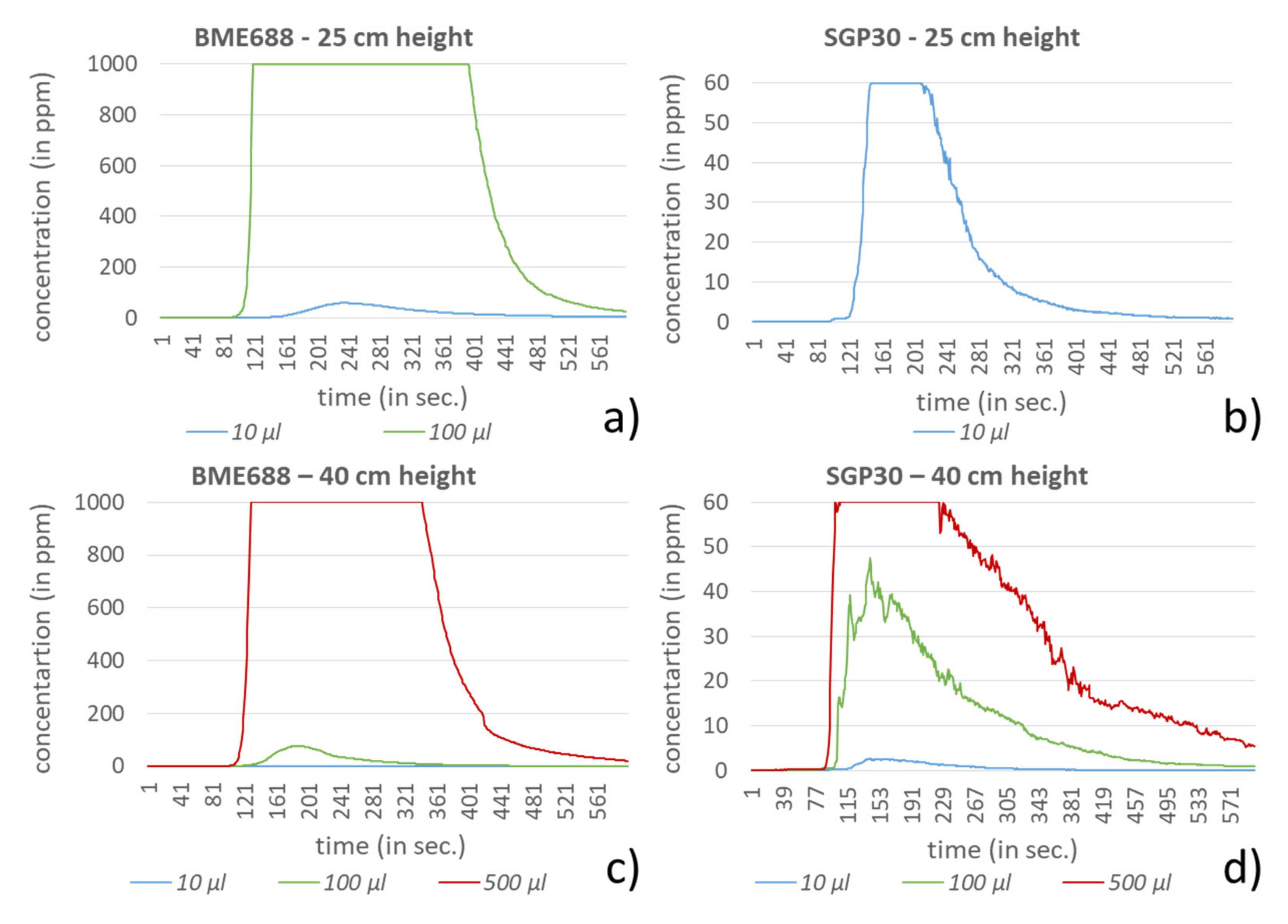

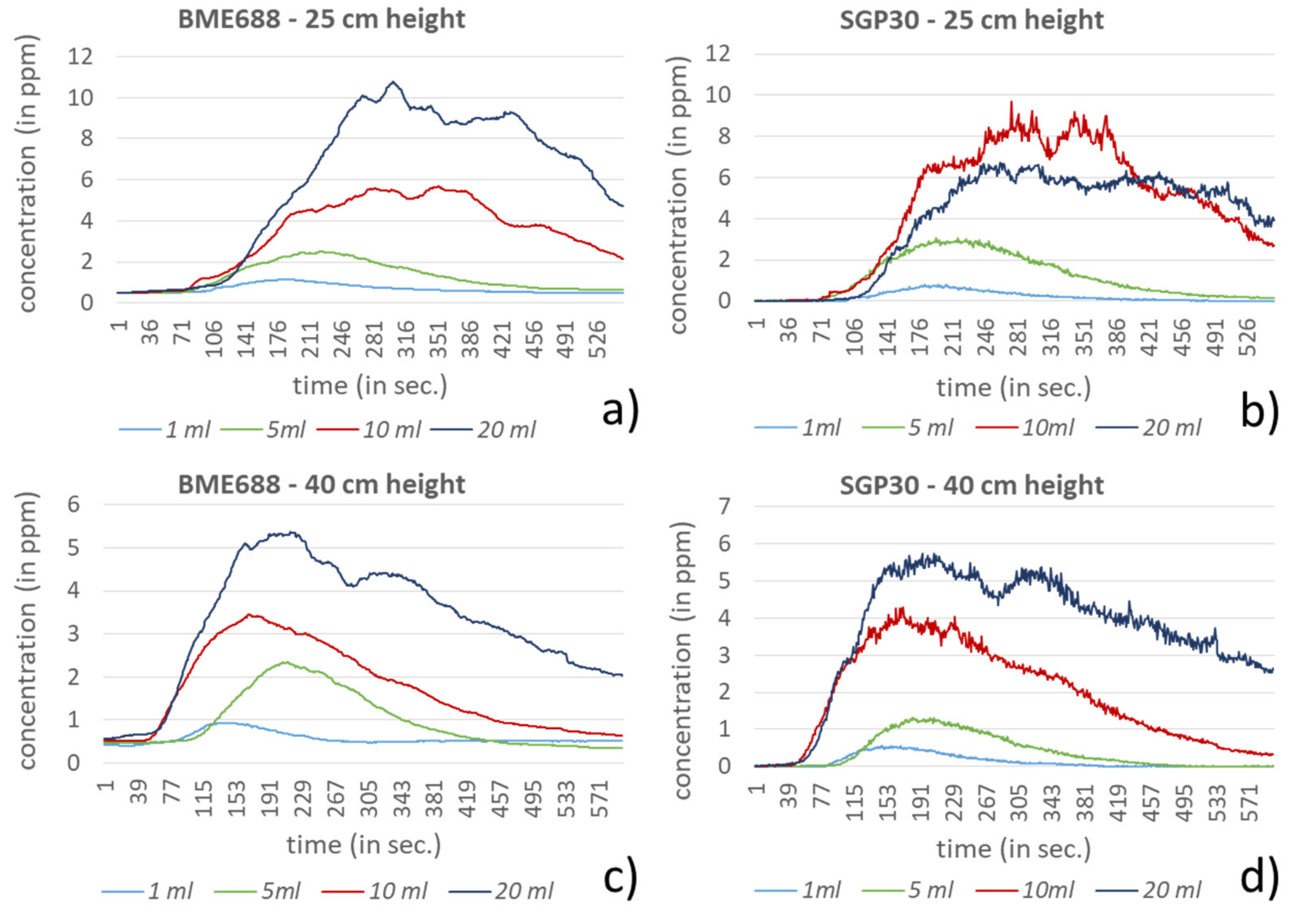
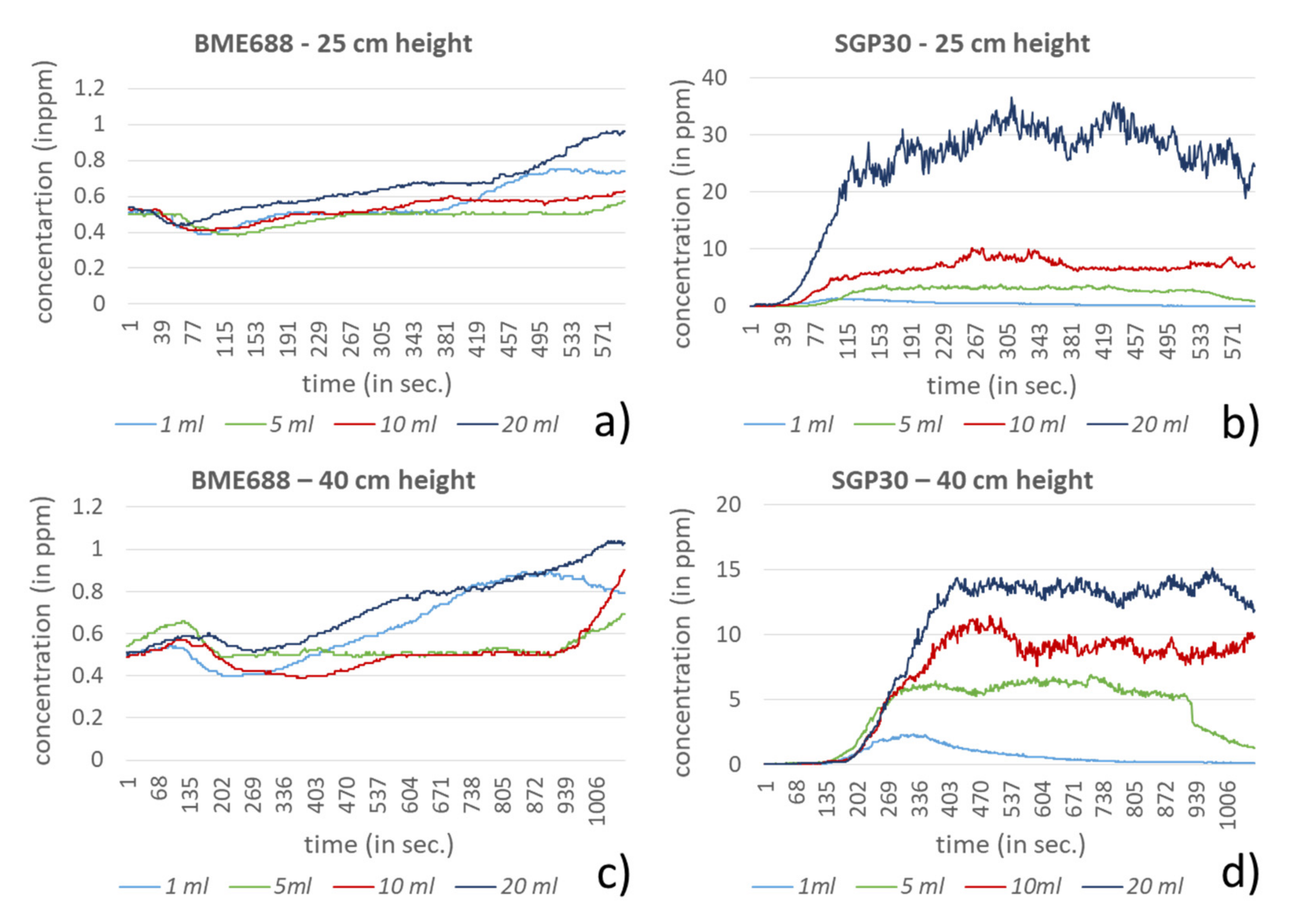

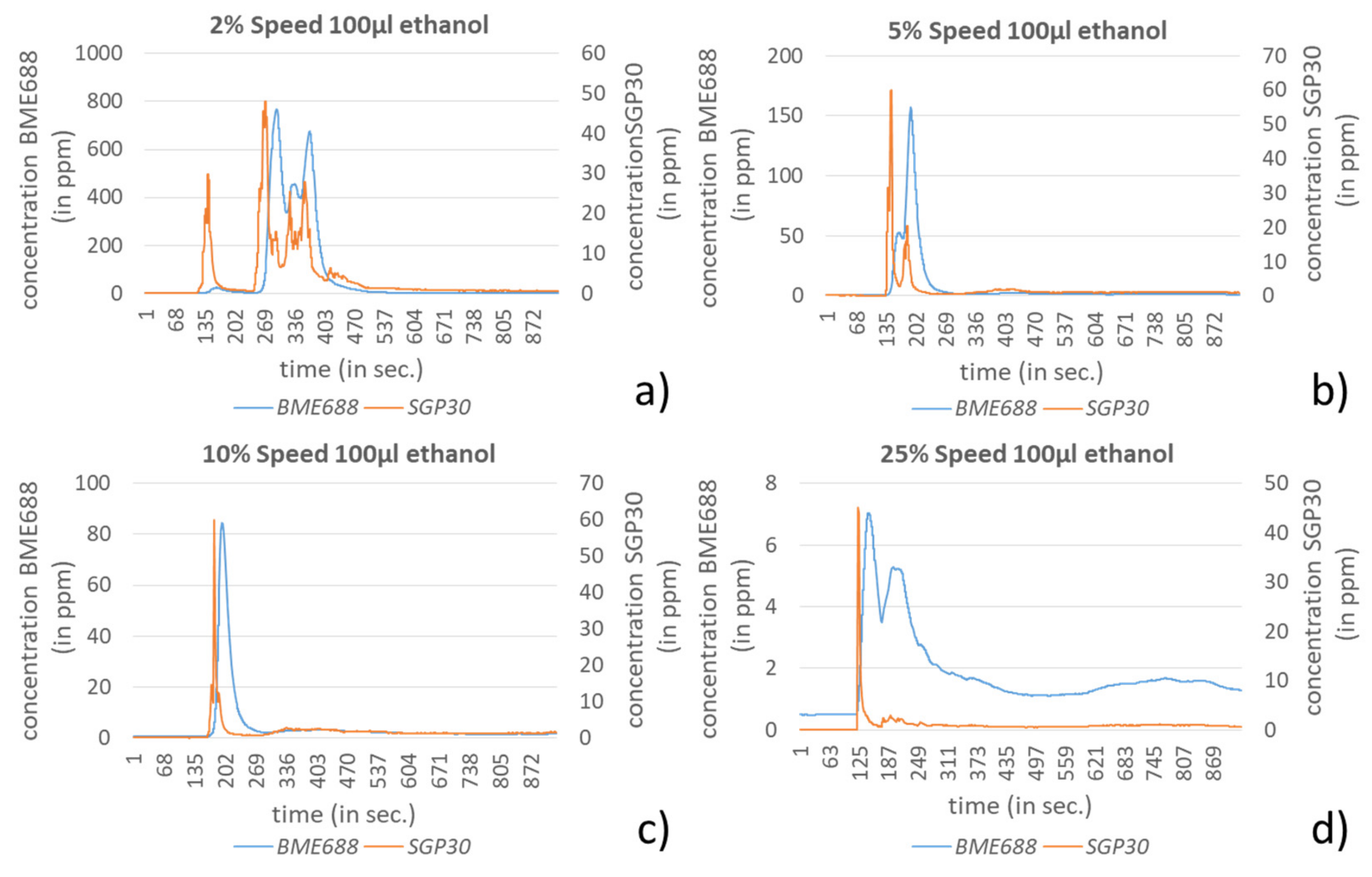
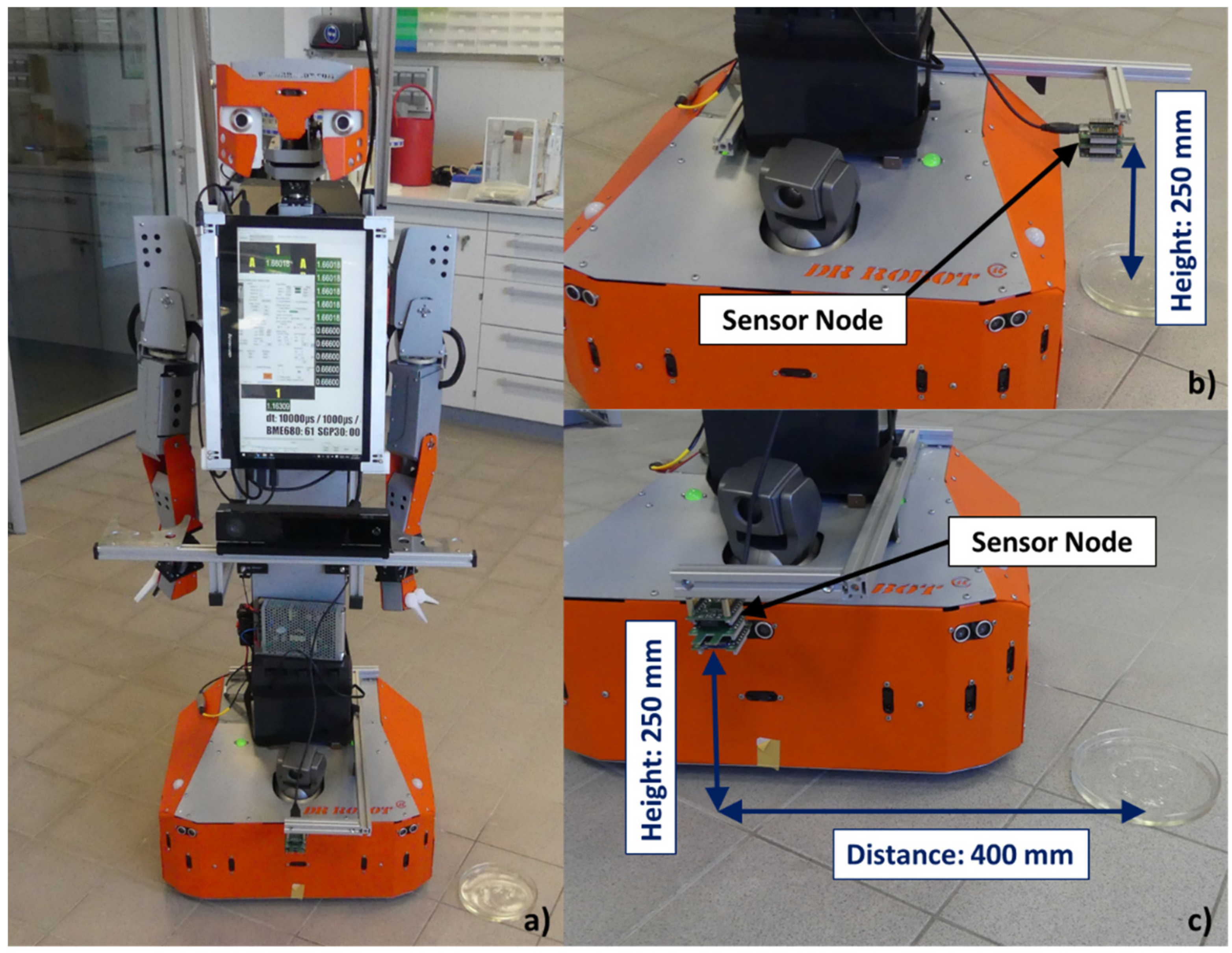

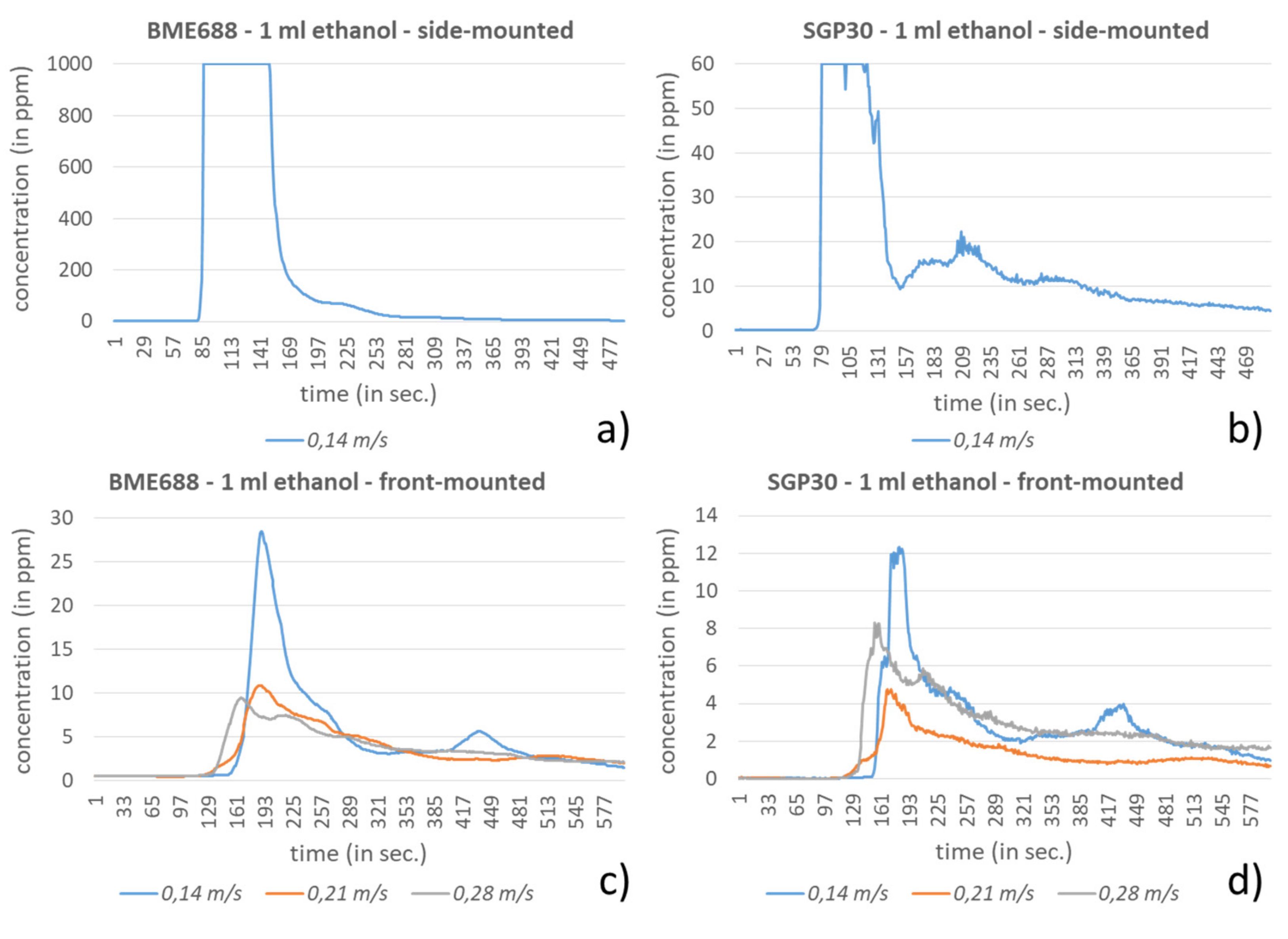
| BME688 [28] | SGP30 [29] | MS5803-05BA [30] | |
|---|---|---|---|
| manufacturer | Bosch | Sensirion | TE connectivity |
| power supply | 1.71–3.6 V | 1.62–1.98 V | 1.8–3.6 V |
| acquired parameter (only major parameters included) | IAQ, CO2 eq., ambient temperature, relative humidity, atmospheric pressure | TVOC, CO2 eq. (H2-based) | atmospheric pressure (high resolution), ambient temperature |
| interfaces | SPI, I2C | I2C (1.8 V) | SPI, I2C |
| size (in mm³) | 3.0 × 3.0 × 0.93 | 2.45 × 2.45 × 0.9 | 6.4 × 6.2 × 2.88 |
Publisher’s Note: MDPI stays neutral with regard to jurisdictional claims in published maps and institutional affiliations. |
© 2021 by the authors. Licensee MDPI, Basel, Switzerland. This article is an open access article distributed under the terms and conditions of the Creative Commons Attribution (CC BY) license (https://creativecommons.org/licenses/by/4.0/).
Share and Cite
Neubert, S.; Roddelkopf, T.; Al-Okby, M.F.R.; Junginger, S.; Thurow, K. Flexible IoT Gas Sensor Node for Automated Life Science Environments Using Stationary and Mobile Robots. Sensors 2021, 21, 7347. https://doi.org/10.3390/s21217347
Neubert S, Roddelkopf T, Al-Okby MFR, Junginger S, Thurow K. Flexible IoT Gas Sensor Node for Automated Life Science Environments Using Stationary and Mobile Robots. Sensors. 2021; 21(21):7347. https://doi.org/10.3390/s21217347
Chicago/Turabian StyleNeubert, Sebastian, Thomas Roddelkopf, Mohammed Faeik Ruzaij Al-Okby, Steffen Junginger, and Kerstin Thurow. 2021. "Flexible IoT Gas Sensor Node for Automated Life Science Environments Using Stationary and Mobile Robots" Sensors 21, no. 21: 7347. https://doi.org/10.3390/s21217347







